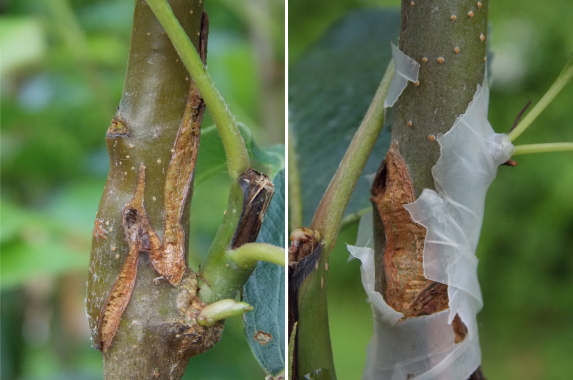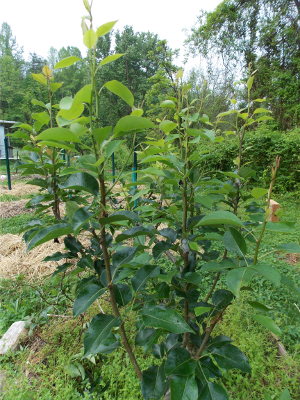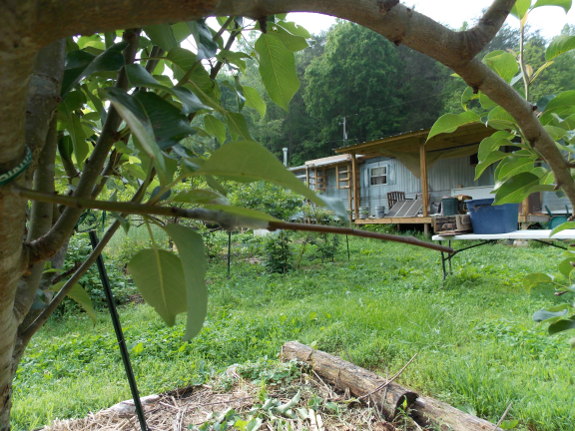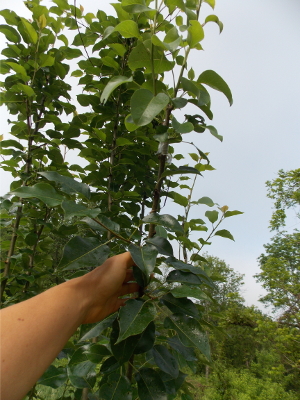
Frameworking followup

 There's nothing like failing
the first time around
to make your ultimate success that much sweeter. That's right ---
the grafts on my frameworked
pears are healing up well, and the growth from the scionwood is
really taking off. I've been ripping off new shoots below the
graft union as I pass the trees by for the past couple of weeks,
ensuring all energy in each grafted twig goes into the new wood, and
now it seems to be time to take off the parafilm before the twigs burst
free of their wrappings.
There's nothing like failing
the first time around
to make your ultimate success that much sweeter. That's right ---
the grafts on my frameworked
pears are healing up well, and the growth from the scionwood is
really taking off. I've been ripping off new shoots below the
graft union as I pass the trees by for the past couple of weeks,
ensuring all energy in each grafted twig goes into the new wood, and
now it seems to be time to take off the parafilm before the twigs burst
free of their wrappings.
The Seckel scionwood I
grafted onto our Keiffer pear is doing an excellent job, with nine out
of ten grafts having taken. The other pear --- with an unknown
variety and Comice replacing the Orient twigs --- isn't as perfect, but
enough grafts have taken there to make the variety changeover.

 I'm not quite sure what the
big difference is between the two trees, but I've got some
guesses. The most obvious factor that determined the success or
failure of a graft was the orientation of the twig I grafted onto ---
vertical watersprouts resulted in fast and prolific growth from the
scionwood (photo to the left) while horizontal twigs (photo above)
often failed to take or started growing late. All of the twigs I
used for the Seckel pear were waterpsprouts, while a lot more of the
other tree's twigs were horizontal.
I'm not quite sure what the
big difference is between the two trees, but I've got some
guesses. The most obvious factor that determined the success or
failure of a graft was the orientation of the twig I grafted onto ---
vertical watersprouts resulted in fast and prolific growth from the
scionwood (photo to the left) while horizontal twigs (photo above)
often failed to take or started growing late. All of the twigs I
used for the Seckel pear were waterpsprouts, while a lot more of the
other tree's twigs were horizontal.
I also forgot to dab a
bit of grafting wax on the ends of the scionwood on the non-Seckel
tree, so those twigs might have dried out (although they don't look
like it). And it's also quite possible the Orient pear just isn't
as amenable of a rootstock --- several of the grafts that did take on
that tree have yellowing leaves on the scionwood and haven't put out
much new wood, while the Seckel scionwood has shoots that are often
nearly a foot long. (This isn't a crazy idea --- some varieties
are incompatible with each other and will simply die if grafted
together.)
The tricky part will be
keeping track of which twigs are the new variety and which belong to
the rootstock, so I can slowly let the former take over the
latter. For now, the graft unions are very visible, but I suspect
they'll disappear into the wood before long. And maybe all this
vigorous growth means we'll enjoy pears of the new varieties by 2015?
Want more in-depth information? Browse through our books.
Or explore more posts by date or by subject.
About us: Anna Hess and Mark Hamilton spent over a decade living self-sufficiently in the mountains of Virginia before moving north to start over from scratch in the foothills of Ohio. They've experimented with permaculture, no-till gardening, trailersteading, home-based microbusinesses and much more, writing about their adventures in both blogs and books.
Want to be notified when new comments are posted on this page? Click on the RSS button after you add a comment to subscribe to the comment feed, or simply check the box beside "email replies to me" while writing your comment.

Colored zip ties, very loosely fastened near your grafted rootstock could help you keep track of things. With the help of a spreadsheet, which we all know you are already fond of, it would be pretty simple, i think!
Try to use darker colored ties-the reds, yellows and oranges can be hard to tell apart after a few seasons in the elements. I've found the green, blue, and black hold their colors better. For added insurance of identification, you could trim the ends of the ties in a fashion that is specific to the type of graft.
I cut open and flatten out an aluminum can, then cut out strips or ovals with a regular scissors. Lay the cut aluminum on an old magazine, and with an old ballpoint pen write the variety, or other information you want on it. Then punch a hole in one end and attach it to a branch with a loose twist of wire. It never fades, rusts, or changes really. You can do the same thing with PET plastic for a clear version, but that will degrade over time.